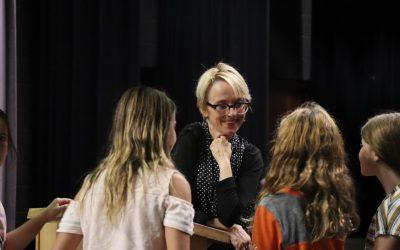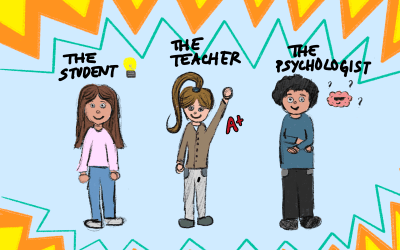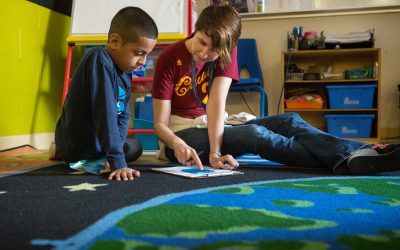In an October blog post, Everything I’ve Ever Needed to Know About Teaching, I Learned From Black Women: A Recommended Reading List, Akosua Lesesne highlighted the groundbreaking works of ten Black women education theorists whose works have for decades deeply influenced her educational and parenting practices. In this blog post, Akosua bridges Culturally Responsive Pedagogy with the Competency-based Learning Cycle, and shares two key opportunities for trying this out in practice.
Oh, the possibilities.
Since joining reDesign, I have been intrigued by the possible benefits to learners if Gloria Ladson-Billings’ theory of Culturally Relevant Pedagogy (CRP) could drive instructors’ approaches to the reDesign Competency-based Learning Cycle. If you haven’t already, you can read this friendly introduction to the Competency-based Learning Cycle here. Oh, the possibilities! In addition to their scholarly acumen, many of the women featured in the aforementioned blog were also practitioners, quite a few of them raised Black children, and all of them were themselves Black students. All three of these elements are true for Ladson-Billings. From the standpoint of a practitioner, these experiences add distinctive depth and credence to their theories and heightened impact in the lives of learners.
To be sure, there are many more than these ten Black women (and men) whose works are part of the bedrock of the field of K-12 education scholarship and practice. Black, as well as Indigenous, Asian and Latinx, scholars and practitioners add to the field every day. In addition to engaging new works, I often come back to the impact and promise that the pioneering works of those ten Black women hold for young people in schools, in general, as well as Black children and others of their marginalized peer groups, in particular.
The three domains of Culturally Relevant Pedagogy.
According to Ladson-Billing (1995), “culturally relevant teaching must meet three criteria: a ability to develop students academically, a willingness to nurture and support cultural competence, and the development of sociopolitical consciousness.” (p. 483).These are the three domains of CRP: 1) Academic Success, 2) Cultural Competence, and 3) Sociopolitical Consciousness. As I reflect on the Competency-based Learning Cycle, it seems clear how this approach to curriculum design and instruction supports such essential practices of the Academic Success domain, such as rich scaffolding, explicit skill and strategy instruction, designing arcs that “bloom” toward high-order thinking, and the emphasis on authentic demonstration of competencies through performance tasks, to name a few. I also see several key opportunities for designing curriculum with the Competency-based Learning Cycle that can align seamlessly to the Cultural Competence and Sociopolitical Consciousness domains of CRP.
I am wholly committed to increasing the percentage of Black teachers in U.S. classrooms for many reasons, including that Black teachers, who currently make up less than 7% of the U.S. teaching force (USDOE, 2016), have been found to have a distinctively positive impact on Black students’ educational well-being and academic success (Gershenson, Holt, and Papageorge, 2016; Gershenson, Hart, Lindsay, and Papageorge, 2017; Grissom and Redding, 2016).
Since the education debt (Ladson-Billings, 2006) to marginalized students remains outstanding, and the opportunity gaps (Carter and Welner, Eds., 2013) between student groups abound, this is a particularly crucial point for those committed to educational equity. For similar reasons, when I am exploring theoretical frameworks that will inform teaching practices in school communities, in general, and predominantly Black school communities, in particular, I emphasize the work of Black scholars, bodies of work have which have been found to be undertheorized in general research on teaching and learning, and underutilized—even derided—in the field (Irvine, 1998, 2002; Foster, 1993, 2018, Milner, 2012; Walker, 1996).
While CRP is extremely popular in research and practice, my experience is that the framework it is often treated as a buffet as opposed to the full multiple course meal that it is.
Leveraging the Learning Cycle.
For the remainder of this piece, I explore the possibilities for driving the reDesign Learning Cycle with all three domains of the CRP framework. When I started at reDesign and began working with the reDesign Learning Cycle, I was immediately impressed by how this learning cycle could be leveraged by instructors to fulfill the Academic Success domain of the CRP framework. Ladson-Billings (2014) defines academic success as, “intellectual growth that students experience as a result of classroom instruction and learning experiences (p. 75).”The reDesign Learning Cycle approach is rooted in the conviction that all students can master the skills required of them to succeed in college and career. For over a decade, reDesigners have successfully supported teachers of alternative school students in driving toward these results. To drive engagement for the beginning, a learning cycle begins with a compelling question or problem frame (a question centering on a real-world issue) and systematically moves students through learning opportunities that lead to the completion of a Performance Task (project or product), which addresses the problem that has been posed. The bank of performance tasks was developed through research on the products that the average college student is required to produce during their first year.
Additionally, the Learning Cycle organizes potent and proven teacher moves and its consistently implementation promotes the incorporation of these moves into daily instruction. As one teacher shared in a recent reDesign professional development session, “I’ve done all of these things in instruction separately before, but never systematically.” That reflection resonated with me. While I learned many of these moves in my teacher education program and others were instinctual to me, I did not have the benefit of learning them systematically nor did I have access to the many learning activities available through reDesign that I could use in daily lessons.
Proven instructional moves related to implementing the Learning Cycle include metacognitive modeling, scaffolding experiences that foster high-order thinking skills (Bloom’s Taxonomy), engaging in conferences, facilitating collaborative learning, and prompting synthesis and reflection. While I learned these things in teacher education program, I spent a good part of my career creating specific instructional strategies that aligned with them. This is a great resource to support instructors in fulfilling the Academic Success domain of CRP. Remembering that the CRP has three domains, there is room within this Learning Cycle to fulfill the remaining two: Cultural Competence and Sociopolitical Consciousness.Ladson-Billings (2014) defines Cultural Competence as, “the ability to help students appreciate and celebrate their cultures of origin while gaining knowledge of and fluency in at least one other culture” and she defines Academic Success as, “the ability to take learning beyond the confines of the classroom using school knowledge and skills to identify, analyze, and solve real-world problems” (p. 75) While the definition here does not emphasize social justice, elsewhere, Ladson-Billings (1995) emphasizes that culturally relevant teachers, “help students to recognize, understand, and critique current social inequities”. (p. 476).
I’ve found that these elements, together with a commitment to the Academic Success domain of CRP are particularly impactful on the educational well-being and academic outcomes for Black and other underserved student groups. It’s been my experience that once opportunities to build cultural competence and develop sociopolitical consciousness elements were incorporated into learning experiences, countless students transformed from seemingly unmotivated and disengaged into high-achieving students and leaders within and beyond their school communities. So, it’s exciting for me to imagine how both Cultural Competence and Sociopolitical Consciousness, along with Academic Success could drive the strong reDesign Learning Cycle from the very beginning.
Opportunity #1: Attend to student culture in the “Making Meaning” and “Investigate” stages
At the lesson level, this Learning Cycle begins with a Make Meaning stage, usually twenty percent of a lesson during which instructors introduce the topic, connect to prior knowledge, and build background knowledge.
From my understanding, in order for instruction to align to the CRP framework, student culture must shape the learning experience beginning in the Make Meaning stage. According to Ladson-Billings (1995), “Culturally relevant teachers utilize students’ culture as a vehicle for learning.” (p. 161). In alignment with Ladson-Billings ideas about teaching through culture, instructors could ensure that they are aware of culturally specific instances of prior knowledge that students bring with them about the topic. For example, in math instructors would research everyday use of geometric concepts or scientific topics within their students’ culture of origin, allow learners to demonstrate this prior knowledge and develop a bridge between this knowledge and school learning.
The same concept would be applied to building background knowledge. This could occur when instructors build background knowledge about culturally significant connections to the topic at hand that expands students’ knowledge and appreciation their own cultures of origin while exposing them to others. Guest speakers from the community who have relevant experience could be engaged to demonstrate this knowledge and help student make connections between their home cultures and the topic.
After the Make Meaning phase, learners move into the Investigate phase of the Learning Cycle. This phase includes highly scaffolded learning experiences that provide students with opportunities to deepen the knowledge and build the skills that will be required to successfully complete the performance task and address the problem frame.
For instance, during the Investigate phase, a unit on eating well could provide learners with the opportunity to engage the histories and traditions of their own food cultures, as well as contemporary healthy-eating initiatives happening in their communities, led by community members from their cultural backgrounds, to address obesity and other health disparities. I imagine taking this approach as opposed to providing students exclusively with Eurocentric or European American food options, cultures, and solutions to challenges to eating well.
Opportunity #2: Create an Inquiry Frame and Performance Task that purposefully builds Cultural Competence and addresses Sociopolitical Issues
I have also found that the Inquiry Frame (More about Inquiry Frames here) itself and the Performance Task could also be driven by all three domains of CRP, including Cultural Competence and Sociopolitical Consciousness. Additionally, worded well and designed effectively, these elements could also be designed as the hook to grab students’ attention from the start of the unit. For example, As opposed to an abstract purely “academic” topic, the Inquiry Frame could pose a relevant, real-world problem like, “How Do We Create a Just Food System?”, and the Performance Task itself could require a real-world action through which students would have the opportunity to build sociopolitical consciousness. Examples of this in Ladson-Billings work include teaching that results in students obtaining knowledge and skills necessary to write and present urban plans to city council about inequitable utilization of space in their communities, develop letters to local newspaper editors exposing school funding inequities, amd planning multimodal strategies to expose the disproportionate presences of liquor stores in their neighborhoods (Ladson-Billings, 1995a, 1995b). Also, recently an article on my social media newsfeed featured a group of parents and students who are suing the state of Rhode Island of failing to provide students with the skills they need to participate effectively in a democracy.
For me, it’s exciting to imagine the type of instruction that would lead to the capacity to take this type of action, and I believe that culturally responsive pedagogy, which fulfills all three domains of teaching, holds that type of potential, as well as the potential to empower young people and change the world.
I am also excited to continue this exploration of how CRP can drive the reDesign Competency-based Learning Cycle and we welcome your examples and ideas! The possibilities are endless.
Banner photograph courtesy of Allison Shelley/The Verbatim Agency for American Education: Images of Teachers and Students in Action
References
Carter, P. L., & Welner, K. G. (Eds.). (2013). Closing the opportunity gap: What America must do to give every child an even chance. Oxford University Press.
Gershenson, S., Hart, C.M.D., Lindsay, C., Papageorge, N.W. (2017). The Long-Run Impacts of Same-Race Teachers. IZA Institute of Labor Economics. Retrieved from http://ftp.iza.org/dp10630.pdf
Gershenson, S., Holt, S., Papageorge, N. W. (2016). Who believes in me? The effect of student–teacher demographic match on teacher expectations.Economics of Education Review, v. 52, p. 209- 224. https://doi.org/10.1016/j.econedurev.2016.03.002
Grissom, J. A., & Redding, C. (2015). Discretion and disproportionality: Explaining the underrepresentation of high-achieving students of color in gifted programs. Aera Open, 2(1), 2332858415622175.
Ladson‐Billings, G. (1995). But that’s just good teaching! The case for culturally relevant pedagogy. Theory into practice, 34(3), 159-165.
Ladson-Billings, G. (1995). Toward a theory of culturally relevant pedagogy. American educational research journal, 32(3), 465-491.
Ladson-Billings, G. (2006). From the achievement gap to the education debt: Understanding achievement in US schools. Educational researcher, 35(7), 3-12.
Altbergs, J. (2017). Framework for Effective Instruction: Knowledge Building Guide
Lesesne, P. (2018). Everything I Needed to Know About Teaching, I Learned from Black Women: Recommended Reading List. www.redesignu.org
Curriculum and Assessment Design | Instructional Coaching and Professional Development | Mastery Learning Systems Design | Teaching and Learning
Join the community!
Sign up to receive our newsletter, access best-of educational resources, and stay in the know on upcoming events and learning opportunities. We hope to see you soon!




